Completed Bachelor and Master Theses
Here, we show an excerpt of bachelor and master theses that have been completed since 2017.
Master Thesis: Immersive Surface Boxplots - Exploring Uncertainty of Scientific Data in VR [in progress]
Scientific data is the basis for the analysis of complex physical
phenomena such as meteorological or biological processes.
However, while often ignored, models and measurements typically
incorporate uncertainties. Visualizing such uncertainties is crucial for
domain experts to truly understand these phenomena, as well as gain a
sense of trust for the reliability of the data.
While approaches exist, that help communicate such uncertainties in
ensembles, such as Surface Boxplots (Genton et al. 2014), these are
typically made for classic desktop environments.
In this thesis, we want to explore, how the additional dimensions
provided by immersive displays could be used to provide an alternative,
more interactive and intuitive encoding of uncertainties in 2D scalar
field ensembles. This includes designing and implementing an immersive
application and evaluating the solution in an appropriate user or expert
study. Further details will be discussed in a meeting.
Contact:
Dr. Tim Gerrits
Master Thesis: Advanced Interaction with Spatial UI [in progress]
Interactions with menus in virtual reality are common when using immersive applications. However, due to various effects such as the lever effect, Heisenberg effect, etc., which are common in standard interaction techniques, menus can be cumbersome to use. This thesis aims to develop and evaluate an advanced interaction technique that aims to overcome the shortcomings of standard interactions.
Prior experience with Unreal Engine’s C++ code or a strong willingness to learn independently and C++ proficiency is a must.
A basic understanding of study design is advantageous.
Contact:
Marcel Krüger, M.Sc.
Master Thesis: Be the teacher! - Viewport Sharing in Collaborative Virtual Environments [in progress]
Have you ever tried to show somebody a star in the night sky by pointing towards it?
Conveying viewport relative information to the people surrounding us is always challenging, which often leads to difficulties and misunderstandings when trying to teach content to others. This issue also occurs in collaborative virtual environments, especially when used in an educational setting. However, virtual reality allows us to manipulate the otherwise constrained space to perceive the viewports of collaborators in a more direct manner.
The goal of this thesis is to develop, analyze, implement and evaluate techniques on how students in a collaborative virtual environment can better perceive the instructor’s viewport. Considerations such as cybersickness, personal space, and performance need to be weighed and compared. The thesis should be implemented in Unity (Unreal can be discussed), and you should be interested in working with networked collaborative environments. Further details will be discussed in a meeting, but experience with Unity or more general Netcode would be very helpful.
Contact:
David Gilbert, M.Sc.
Master Thesis: Impact of Framerate in Virtual Reality [in progress]
When talking about rendering in virtual reality high framerates and low latency are said to be crucial. While there is a lot of research regarding the impact of latency on the user this master thesis aims to focus on the impact of the framerate. The goal of the thesis is to design and evaluate a VR application that measures the influence of the framerate on the user. The solution should be evaluated in an expert study. Further details will be discussed in a meeting.
Contact:
Marcel Krüger, M.Sc.
Simon Oehrl, M. Sc.
Bachelor Thesis: Interaction with Biological Neural Networks in the Context of Brain Simulation [in progress]
The ability to explore and analyze data generated by brain simulations can give various new insights about the inner workings of neural networks. One of the biggest challenges is to find interaction techniques and user interfaces that allow scientists to easily explore these types of data. Immersive technology can aid in this task and support the user in finding relevant information in large-scale neural networks simulations. The goal of this thesis is to explore techniques to view and interact with biological neural networks from a brain simulation in Unreal Engine 4. The solution should provide easy-to-use and intuitive abilities to explore the network and access neuron-specific properties/data.
A strong background in C++ is needed, experience with UE4 would be very helpful. Since this thesis focuses on the visualization of such networks, an interest in immersive visualization is needed, knowledge about neural networks or brain simulation is not necessary.
Contact:
Marcel Krüger, M.Sc.
Bachelor/Master Thesis: Exploring Immersive Visualization of Artificial Neural Networks with the ANNtoNIA Framework [in progress]
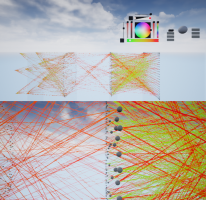 The ANNtoNIA framework is currently developed at the Visual Computing Institute to provide a simple way for machine learning researchers, teachers, and students to utilize immersive visualization. The goal of this thesis is the development and evaluation of visualizations that utilize the ANNtoNIA framework that provides any kind of insight into the inner workings of neural networks. In the process, the capabilities of the framework should be utilized, demonstrated, and extended, depending on the visualization the thesis aims to pursue.
If you are interested in this thesis, you should be interested in artificial neural networks and machine learning as well as immersive visualization. Experience with Unreal Engine, C++, and Python would be very helpful. You should be a creative thinker and be able to set your own goals within a given frame. In return, this thesis offers you the opportunity to explore a topic of your choice within the field of artificial neural networks with a lot of creative freedom.
The ANNtoNIA framework is currently developed at the Visual Computing Institute to provide a simple way for machine learning researchers, teachers, and students to utilize immersive visualization. The goal of this thesis is the development and evaluation of visualizations that utilize the ANNtoNIA framework that provides any kind of insight into the inner workings of neural networks. In the process, the capabilities of the framework should be utilized, demonstrated, and extended, depending on the visualization the thesis aims to pursue.
If you are interested in this thesis, you should be interested in artificial neural networks and machine learning as well as immersive visualization. Experience with Unreal Engine, C++, and Python would be very helpful. You should be a creative thinker and be able to set your own goals within a given frame. In return, this thesis offers you the opportunity to explore a topic of your choice within the field of artificial neural networks with a lot of creative freedom.
Contact:
Martin Bellgardt, M. Sc.
Bachelor Thesis: Group Navigation with Virtual Agents [in progress]
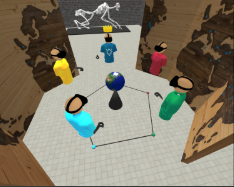 Architectural environments such as cities or museums are communal places. Thus, populating these scenes with computer-controlled virtual agents as virtual pedestrians adds plausibility and realism to the overall scenario. To meet the user’s nature of being a social being, these pedestrians shall be user-aware. One crucial aspect here is group navigation, divided into the following four stages: forming a navigational group (forming) with the user, distribute navigational responsibilities (norming), navigate together (performing), and finally, splitting up again (adjourning).
Architectural environments such as cities or museums are communal places. Thus, populating these scenes with computer-controlled virtual agents as virtual pedestrians adds plausibility and realism to the overall scenario. To meet the user’s nature of being a social being, these pedestrians shall be user-aware. One crucial aspect here is group navigation, divided into the following four stages: forming a navigational group (forming) with the user, distribute navigational responsibilities (norming), navigate together (performing), and finally, splitting up again (adjourning).
(Image on the right taken from Weissker and B. Fröhlich, TCVG, 2021)
The goal of this thesis is to design the three stages of forming, performing, and adjourning for the use case of a guided tour through a virtual city. A virtual guide takes over the global wayfinding responsibilities (norming) and guides the group on a predefined path through the scene while walking in front of the group. The design and implementation focus is thereby on the behavior of the virtual participants of the tour. The research objective is to design the navigational group in a way, that the user feels comfortable, perceives a high level of social presence, and experiences being part of the social group. A small HMD-based user study should be performed in the end evaluating the algorithmic design of the group navigation.
Contact:
Dr. Andrea Bönsch
Bachelor Thesis: Walking and Talking Side-by-Side with a Virtual Agent [in progress]
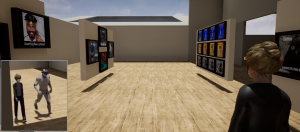
- Common head-mounted displays (HMDs) only provide a small field of view, thus limiting the peripheral view of the user. To this end, seeing an agent in a side-by-side alignment is either hampered or not possible at all without constantly turning one’s head. For room-mounted displays such as CAVEs with at least three projection screens, the alignment itself is possible.
- Which interaction partner aligns with the other? Influencing aspects here are, e.g., is the goal of the joint locomotion known by both walkers, or just by one?
- For the fine-grained alignment, the agent’s animation or the user’s navigation strategy needs to allow many nuances, trajectory- and speed-wise.
Contact:
Dr. Andrea Bönsch
Master Thesis: Exploring a Virtual City with an Accompanying Guide [in progress]
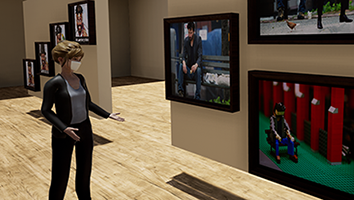 After becoming familiar with the respective VR equipment, the first task carried out by users in a VR environment is scene exploration. A common approach to support users in this task is embedding a computer-controlled anthropomorphic character, a so-called virtual agent (VA), fulfilling the role of a virtual guide. This VA guides the user through the scene and thus allows for a structured experience while avoiding that the user gets lost in complex scenes or misses critical information. Although the user can now fully concentrate on gaining knowledge, he or she becomes a passive receiver reducing the sense of personal agency as well as user investment. Active exploration with exploratory freedom, in contrast, accompanied by a knowledgeable VA as alternative hasn’t been proven too effective either, as a structured experience was missing.
To this end, this master thesis focus on the design, implementation and evaluation of an ECA combining both aforementioned roles in context of exploring a virtual city. The ECA shall allow an interactive and adaptable, however, structured experience. Users should be able to influence the structure of their experience to a certain degree, while the ECA ensures that no critical information is missed. Additionally, the level of detail for the explanations given by the ECA should be controllable, either directly by the user via natural language or by an intelligent ECA interpreting the user’s behavior, e.g., his or her attention level either as bored or interested. A short summary should then be available for uninterested users, while a detailed explanation should be given to curious ones.
After becoming familiar with the respective VR equipment, the first task carried out by users in a VR environment is scene exploration. A common approach to support users in this task is embedding a computer-controlled anthropomorphic character, a so-called virtual agent (VA), fulfilling the role of a virtual guide. This VA guides the user through the scene and thus allows for a structured experience while avoiding that the user gets lost in complex scenes or misses critical information. Although the user can now fully concentrate on gaining knowledge, he or she becomes a passive receiver reducing the sense of personal agency as well as user investment. Active exploration with exploratory freedom, in contrast, accompanied by a knowledgeable VA as alternative hasn’t been proven too effective either, as a structured experience was missing.
To this end, this master thesis focus on the design, implementation and evaluation of an ECA combining both aforementioned roles in context of exploring a virtual city. The ECA shall allow an interactive and adaptable, however, structured experience. Users should be able to influence the structure of their experience to a certain degree, while the ECA ensures that no critical information is missed. Additionally, the level of detail for the explanations given by the ECA should be controllable, either directly by the user via natural language or by an intelligent ECA interpreting the user’s behavior, e.g., his or her attention level either as bored or interested. A short summary should then be available for uninterested users, while a detailed explanation should be given to curious ones.
Contact:
Dr. Andrea Bönsch
Master Thesis: Unaided Scene Exploration while being Guided by Pedestrians-as-Cues [in progress]
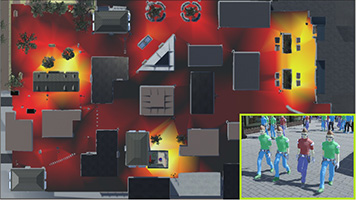 After becoming familiar with the respective VR equipment, the first task carried out by users in a VR environment is scene exploration. While there are many techniques for aided scene exploration such as guides, signs, and maps, unaided wayfinding through pedestrians-as-cues has not been investigated closely, yet.
After becoming familiar with the respective VR equipment, the first task carried out by users in a VR environment is scene exploration. While there are many techniques for aided scene exploration such as guides, signs, and maps, unaided wayfinding through pedestrians-as-cues has not been investigated closely, yet.
As it becomes more and more common to enliven virtual scenes with computer-controlled anthropomorphic characters, so-called virtual agents (VAs), using them to subtly guide users is a promising approach. As in reality, the amount of pedestrians crowding a place may indicate its importance or popularity; the same is true for the number of pedestrians walking in a particular direction.
In this thesis, you will thus algorithmically model pedestrian behavior to guide users to areas of interest throughout a respective scene while investigating the pedestrians’ impact on a user’s comfort, spatial awareness, and (social) presence.
Contact:
Dr. Andrea Bönsch
Bachelor Thesis: Teacher Training System to Experience how own Behavior Influences Student Behavior [in progress]
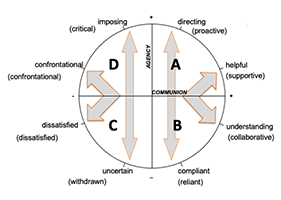 In this bachelor thesis, you will design and implement an HMD-based training system, allowing student teachers to train classroom management. Specifically, the system shall provide student teachers a simulation, which offers them to experience how their own behaviour influences and triggers student behaviour. This simulation should be based on the principle of interpersonal complementarity (cp. Figure taken from Mainhard, 2016), which describes basic action-reaction patterns in human relations.
In this bachelor thesis, you will design and implement an HMD-based training system, allowing student teachers to train classroom management. Specifically, the system shall provide student teachers a simulation, which offers them to experience how their own behaviour influences and triggers student behaviour. This simulation should be based on the principle of interpersonal complementarity (cp. Figure taken from Mainhard, 2016), which describes basic action-reaction patterns in human relations.
As a basis, the training system will comprise a virtual classroom, a set of virtual agents fulfilling the roles of students, and various animations for different student behaviour. The system will continuously measure a user’s behaviour such as tone of voice, gestures, or proxemics, interpret them in real-time based on the Teacher Interpersonal Circle (cf. figure) and trigger appropriate responses of the virtual students. Instead of simulating a complete lesson, you will focus on a small set of specific moments, e.g., starting a lesson or dealing with an unmotivated student.
For this topic, we team up with experts of Zuyd University of Applied Sciences, Utrecht University, and Wageningen University & Research, who are actively involved in teacher education and can provide video footage of those situations in real teaching contexts. Furthermore, as the underlying framework, you will work with the Unreal-based software stack of the project Breaking Bad Behavior of University Würzburg.
Contact:
Jonathan Ehret, M.Sc.
Dr. Andrea Bönsch
Bachelor/Master Thesis: Immersive Node Link Visualization of Invertible Neural Networks
Neural networks have the ability to approximate arbitrary functions. For example, neural networks can model manufacturing processes, i.e., given the machine parameters, a neural network can predict the properties of the resulting work piece. In practice, however, we are more interested in the inverse problem, i.e., given the desired work piece properties, generate the optimal machine parameters. Invertible neural networks (INNs) have shown to be well suited to address this challenge. However, like almost all kinds of neural networks, they are an opaque model. This means that humans cannot easily interpret the inner workings of INNs. To gain insights into the underlying process and the reasons for the model’s decisions, an immersive visualization should be developed in this thesis. The visualization should make use of the ANNtoNIA framework (developed at VCI), which is based on Python and Unreal Engine 4.
Requirements are a basic understanding of Machine Learning and Neural Networks as well as good Python programming skills. Understanding of C++ and Unreal Engine 4 is a bonus but not necessary.
Contact:
Martin Bellgardt, M. Sc.
Master Thesis: Automatic Gazing Behavior for Virtual Agents Based on the Visible Scene Content [in progress]
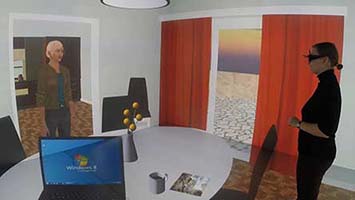 Virtual Agents are often used to enliven virtual scenes and to assist or teach a human user. Thereby especially their gazing behavior is of importance since we, as humans, are very trained on inferring intention (and feelings) from another human’s gazing behavior. This thesis is two-fold: First, state-of-the-art concepts for natural gazing behavior during conversations and, e.g., while thinking or ideling, should be enhanced by an environment-aware gazing. Therefore, e.g., recent research on gaze prediction for humans immersed in a virtual environment or shall be applied. Furthermore, reactions to dynamic changes within the virtual environment itself should be taken into account , e.g., reactions on other agents or the user’s movement. The second part of the thesis is then to develop and conduct a small user study to evaluate the implemented concepts.
Virtual Agents are often used to enliven virtual scenes and to assist or teach a human user. Thereby especially their gazing behavior is of importance since we, as humans, are very trained on inferring intention (and feelings) from another human’s gazing behavior. This thesis is two-fold: First, state-of-the-art concepts for natural gazing behavior during conversations and, e.g., while thinking or ideling, should be enhanced by an environment-aware gazing. Therefore, e.g., recent research on gaze prediction for humans immersed in a virtual environment or shall be applied. Furthermore, reactions to dynamic changes within the virtual environment itself should be taken into account , e.g., reactions on other agents or the user’s movement. The second part of the thesis is then to develop and conduct a small user study to evaluate the implemented concepts.
Contact:
Jonathan Ehret, M.Sc.
Master Thesis: Active Bezel Correction to Reduce the Transparency Illusion of Visible Bezels Behind Opaque Virtual Objects
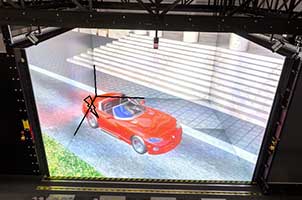 In many room-mounted VR systems, bezels exist between separate screens or at the corners and edges of CAVE screens. If an opaque object is virtually displayed in front of the screen and a bezel is visible behind this object then conflicting depth cues lead to the virtual object appearing transparent especially for novice users. A possible solution is to virtually reproduce the bezel such that for a viewer the bezel (i.e. two versions of it) are virtually moved in front of the object or to the surface of it. The scope of this thesis would be to further improve an existing prototype of this especially by adding the possibility to move the bezel onto the surface of no-flat objects. Furthermore, a user study should be designed and conducted to prove that this technique lowers the problem of objects appearing translucent.
In many room-mounted VR systems, bezels exist between separate screens or at the corners and edges of CAVE screens. If an opaque object is virtually displayed in front of the screen and a bezel is visible behind this object then conflicting depth cues lead to the virtual object appearing transparent especially for novice users. A possible solution is to virtually reproduce the bezel such that for a viewer the bezel (i.e. two versions of it) are virtually moved in front of the object or to the surface of it. The scope of this thesis would be to further improve an existing prototype of this especially by adding the possibility to move the bezel onto the surface of no-flat objects. Furthermore, a user study should be designed and conducted to prove that this technique lowers the problem of objects appearing translucent.
Contact:
Jonathan Ehret, M.Sc.
Bachelor/Master Thesis: Augmented Reality for Process Documentation in Textile Engineering [in progress]
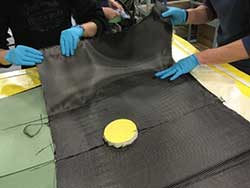 The production of fiber-reinforced plastics (FRP) usually requires a lot of expert knowledge possessed by individual workers. To further improve and automate this process, this knowledge needs to be accessible in a digital form. In a collaboration between the institutes for textile engineering (ITA) and visual computing (VCI) of RWTH Aachen University, we want to address this problem using an Augmented Reality (AR) application. This application should allow users to record, label and classify errors during various production steps and trace these errors through the production chain.
The goal of this thesis is to evaluate AR user interfaces and visualizations for error labeling and classification in the context of production of FRPs. The thesis should include the implementation of a prototypical application running on AR hardware.
The production of fiber-reinforced plastics (FRP) usually requires a lot of expert knowledge possessed by individual workers. To further improve and automate this process, this knowledge needs to be accessible in a digital form. In a collaboration between the institutes for textile engineering (ITA) and visual computing (VCI) of RWTH Aachen University, we want to address this problem using an Augmented Reality (AR) application. This application should allow users to record, label and classify errors during various production steps and trace these errors through the production chain.
The goal of this thesis is to evaluate AR user interfaces and visualizations for error labeling and classification in the context of production of FRPs. The thesis should include the implementation of a prototypical application running on AR hardware.
Contact:
Martin Bellgardt, M. Sc.
Bachelor Thesis: Fast Body Avatar Calibration Based on Limited Sensor Input
![]() While experiencing an immersive virtual environment (IVE) under a head-mounted display (HMD), users are unable to see the real world and thus do not perceive their own body. To this end, body avatars are embedded, mimicking the user’s real movements and postures.
In this bachelor thesis, a fast and easy calibration procedure for a full-body avatar will be developed. It will be only based on the two input devices of the HTC Vive, two additional trackers attached to the user’s legs, and the HTC Vive itself. While different avatar appearances, e.g., human-like or robot-like, should be provided, the animation accuracy as well as the resulting body-ownership illusion will be in focus.
While experiencing an immersive virtual environment (IVE) under a head-mounted display (HMD), users are unable to see the real world and thus do not perceive their own body. To this end, body avatars are embedded, mimicking the user’s real movements and postures.
In this bachelor thesis, a fast and easy calibration procedure for a full-body avatar will be developed. It will be only based on the two input devices of the HTC Vive, two additional trackers attached to the user’s legs, and the HTC Vive itself. While different avatar appearances, e.g., human-like or robot-like, should be provided, the animation accuracy as well as the resulting body-ownership illusion will be in focus.
Figure: User observing his body avatar in an IVE (adapted from Kilias et al., 2019).
Contact:
Dr. Andrea Bönsch
Jonathan Ehret, M.Sc.
Bachelor Thesis: Benchmarking Interactive Crowd Simulations for Virtual Environments in HMD and CAVE Settings
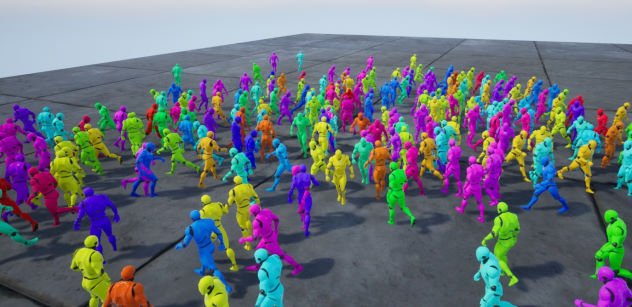 Crowd simulations describe the autonomous navigation of a plethora of virtual entities, here specifically computer-controlled, embodied and human-like virtual agents, through a virtual scene. Dealing with virtual crowds in VR applications means handling a huge amount of individual entities while high and interactive framerates are required. This brings up the combined challenges of scalability, rendering strategy and level of detail. Scalability thereby refers to the number of agents considered in the computation of the crowd simulation itself, while the rendering strategy refer to techniques neglecting agents out of sight during the rendering. For the level of detail aspect, the agents’ appearance and rendering style has to be considered as well as the richness of animations used to create convincingly realistic agents.
This bachelor thesis will provide insight into the performance behavior of crowd simulations in HMD- and CAVE-like environments. Focusing on the Unreal Engine 4, a plugin for benchmarking the performance will be implemented. It will then be used to benchmark two crowd algorithms in an architectural walkthrough scenario with different agent numbers, rendering strategies as well as appearances (cylinder, wooden mannequin, low-polygon character, high-polygon character) and level of detail renderings. The benchmarks will be measured for a setup based on the HTV Vive Pro as well as a setup based on the aixCAVE at RWTH Aachen University.
Crowd simulations describe the autonomous navigation of a plethora of virtual entities, here specifically computer-controlled, embodied and human-like virtual agents, through a virtual scene. Dealing with virtual crowds in VR applications means handling a huge amount of individual entities while high and interactive framerates are required. This brings up the combined challenges of scalability, rendering strategy and level of detail. Scalability thereby refers to the number of agents considered in the computation of the crowd simulation itself, while the rendering strategy refer to techniques neglecting agents out of sight during the rendering. For the level of detail aspect, the agents’ appearance and rendering style has to be considered as well as the richness of animations used to create convincingly realistic agents.
This bachelor thesis will provide insight into the performance behavior of crowd simulations in HMD- and CAVE-like environments. Focusing on the Unreal Engine 4, a plugin for benchmarking the performance will be implemented. It will then be used to benchmark two crowd algorithms in an architectural walkthrough scenario with different agent numbers, rendering strategies as well as appearances (cylinder, wooden mannequin, low-polygon character, high-polygon character) and level of detail renderings. The benchmarks will be measured for a setup based on the HTV Vive Pro as well as a setup based on the aixCAVE at RWTH Aachen University.
Contact:
Dr. Andrea Bönsch
Bachelor Thesis: Investigating the effect of incorrect lighting on the user
 Correct lighting is essential for high fidelity graphics applications but for real-time applications another crucial aspect is the framerate at which the scene is rendered. This is especially true for virtual reality applications that require a framerate of 90Hz to minimize the motion to photon latency in order to prevent negative effects like cyber sickness. One solution to this problem is warping the image of the previous frame to display it from a new location. This approach has many drawbacks. One of them is that the formulas used for light calculations, e.g., the Fresnel’s equations but also the still widespread Blinn-Phong model, are heavily dependent on the viewer’s position. This means that the lighting in the warped image will always be wrong. This bachelor thesis should investigate the effect of incorrect lighting on the user by creating a small project that highlights this issue and designing as well as performing a user study. (Photo: ©Unreal Engine Realistic Rendering Example)
Correct lighting is essential for high fidelity graphics applications but for real-time applications another crucial aspect is the framerate at which the scene is rendered. This is especially true for virtual reality applications that require a framerate of 90Hz to minimize the motion to photon latency in order to prevent negative effects like cyber sickness. One solution to this problem is warping the image of the previous frame to display it from a new location. This approach has many drawbacks. One of them is that the formulas used for light calculations, e.g., the Fresnel’s equations but also the still widespread Blinn-Phong model, are heavily dependent on the viewer’s position. This means that the lighting in the warped image will always be wrong. This bachelor thesis should investigate the effect of incorrect lighting on the user by creating a small project that highlights this issue and designing as well as performing a user study. (Photo: ©Unreal Engine Realistic Rendering Example)
Contact:
Simon Oehrl, M. Sc.
Master Thesis: Frame extrapolation to enhance rendering framerate
 One challenge in Virtual Reality applications is to maintain a consistent framerate of 90Hz in order to reduce the latency between the head movement of the user and updating the displayed image from the new position. Failing to deliver these framerates can lead to cyber sickness and a bad experience for the user. For these reasons TimeWarp techniques exist that reproject the image of the previous frame to a new position in case of missed frames which helps to maintain a reasonable framerate but also introduces visual artifacts because of missing information. This bachelor thesis aims to examine other, more advanced, TimeWarp techniques to hopefully reduce the visual artifacts and enhance the user experience. (Photo: ©UNVIDIA GDC 2015: VR Direct)
One challenge in Virtual Reality applications is to maintain a consistent framerate of 90Hz in order to reduce the latency between the head movement of the user and updating the displayed image from the new position. Failing to deliver these framerates can lead to cyber sickness and a bad experience for the user. For these reasons TimeWarp techniques exist that reproject the image of the previous frame to a new position in case of missed frames which helps to maintain a reasonable framerate but also introduces visual artifacts because of missing information. This bachelor thesis aims to examine other, more advanced, TimeWarp techniques to hopefully reduce the visual artifacts and enhance the user experience. (Photo: ©UNVIDIA GDC 2015: VR Direct)
Contact:
Simon Oehrl, M. Sc.
Bachelor Thesis: The grid processing library
Scalar, vector, tensor and higher-order fields are commonly used to represent scientific data in various disciplines including geology, physics and medicine. Although standards for storage of such data exists (e.g. HDF5), almost every application has its custom in-memory format. The core idea of this engineering-oriented work is to develop a library to standardize in-memory representation of such fields, and providing functionality for (parallel) per-cell and per-region operations on them (e.g. computation of gradients/Jacobian/Hessian).
Contact:
Ali Can Demiralp, M. Sc.
Bachelor Thesis: Scalar and vector field compression for GPUs based on ASTC texture compression [in progress]
Scalar and vector fields are N-dimensional, potentially non-regular, grids commonly used to store scientific data. Adaptive Scalable Texture Compression (ASTC) is a lossy block-based texture compression method, which covers the features of all texture compression approaches to date and more. The limited memory space of GPUs pose a challenge to interactive compute and visualization on large datasets. The core idea of this work is to explore the potential uses of ASTC for compression of large 2D/3D scalar and vector fields, attempting the minimize and bound the errors introduced by lossiness.
Contact:
Ali Can Demiralp, M. Sc.
Master Thesis: The multi-device ray tracing library
There are various solutions for ray tracing on CPUs and GPUs today: Intel Embree for shared parallelism on the CPU, Intel Ospray for distributed parallelism on the CPU, NVIDIA OptiX for shared and distributed parallelism on the GPU. Each of these libraries have their pros and cons. Intel Ospray scales to distributed settings for large data visualization, however is bound by the performance of the CPU which is subpar to the GPU for the embarassingly-parallel problem of ray tracing. NVIDIA OptiX provides a powerful programmable pipeline similar to OpenGL but is bound by the memory limitations of the GPU. The core idea of this engineering-oriented work is to develop a library (a) enabling development of ray tracing algorithms without explicit knowledge of the device the algorithm will run on, (b) bringing ease-of-use of Intel Ospray and functional programming concepts of NVIDIA OptiX together.
Contact:
Ali Can Demiralp, M. Sc.
Master Thesis: Numerical relativity library
Numerical relativity is one of the branches of general relativity that uses numerical methods to analyze problems. The primary goal of numerical relativity is to study spacetimes whose exact form is not known. Within this context the geodesic equation generalizes the notion of a straight line to curved spacetime. The core idea of this work is to develop a library for solving the geodesic equation, which in turn enables 4-dimensional spacetime ray tracing. The implementation should at least provide the Schwarzschild and Kerr solutions to the Einstein Field Equations, providing visualizations of non-rotating and rotating uncharged black holes.
Contact:
Ali Can Demiralp, M. Sc.
Master Thesis: Mean curvature flow for truncated spherical harmonics expansions
Curvature flows produce successively smoother approximations of a given piece of geometry, by reducing a fairing energy. Within this context, mean curvature flow is a curvature flow defined for hypersurfaces in a Riemannian manifold (e.g. smooth 3D surfaces in Euclidean space), which emphasizes regions of higher frequency and converges to a sphere. Truncated spherical harmonics expansions are commonly used to represent scientific data as well as arbitrary geometric shapes. The core idea of this work is to establish the mathematical concept of mean curvature flow within the spherical harmonics basis, which is empirically done through interpolation of the harmonic coefficients to the coefficient 0,0.
Contact:
Ali Can Demiralp, M. Sc.
Master Thesis: Orientation distribution function topology
Topological data analysis methods have been applied extensively to scalar and vector fields for revealing features such as critical and saddle points. There is recent effort on generalizing these approaches to tensor fields, although limited to 2D. Orientation distribution functions, which are the spherical analogue to a tensor, are often represented using truncated spherical harmonics expansions and are commonly used in visualization of medical and chemistry datasets. The core idea of this work is to establish the mathematical framework for extraction of topological skeletons from an orientation distribution function field.
Contact:
Ali Can Demiralp, M. Sc.
Master Thesis: Variational inference tractography
Tractography is a method for estimation of nerve tracts from discrete brain data, often obtained through Magnetic Resonance Imaging. The family of Markov Chain Monte Carlo (MCMC) methods form the current standard to (global) tractography, and have been extensively researched to date. Yet, Variational Inference (VI) methods originating in Machine Learning provide a quicker alternative to statistical inference. Stein Variational Gradient Descent (SVGD) is one such method which not only extracts minima/maxima but is able to estimate the complete distribution. The core idea of this work is to apply SVGD to tractography, working with both Magnetic Resonance and 3D-Polarized Light Imaging data.
Contact:
Ali Can Demiralp, M. Sc.
Master Thesis: Block connectivity matrices
Connectivity matrices are square matrices for describing structural and functional connections between distinct brain regions. Traditionally, connectivity matrices are computed for segmented brain data, describing the connectivity e.g. among Brodmann areas in order to provide context to the neuroscientist. The core idea in this work is to take an alternative approach, dividing the data into a regular grid and computing the connectivity between each block, in a hierarchical manner. The presentation of such data as a matrix is non-trivial, since the blocks are in 3D and the matrix is bound to 2D, hence it is necessary to (a) reorder the data using space filling curves so that the spatial relationship between the blocks are preserved (b) seek alternative visualization techniques to replace the matrix (e.g. volume rendering).
Contact:
Ali Can Demiralp, M. Sc.
Bachelor Thesis: Lip Sync in Unreal Engine 4 [in progress]
Computer-controlled, embodied, intelligent virtual agents are increasingly often embedded in various applications to enliven the virtual sceneries. Thereby, conversational virtual agents are of prime importance. To this end, adequate mimics and lip sync is required to show realistic and plausible talking characters. The goal of this bachelor thesis is to enable an effective however easy-to-integrate lip sync in our Unreal projects for text-to-speech input as well as recorded speech.
Contact:
Jonathan Ehret, M.Sc.
Master Thesis: Meaningful and Self-Reliant Spare Time Activities of Virtual Agents
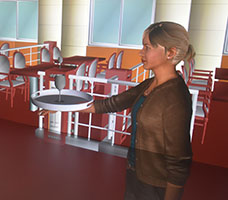
Contact:
Dr. Andrea Bönsch
Jonathan Ehret, M.Sc.
Bachelor Thesis: Joining Social Groups of Conversational Virtual Agents
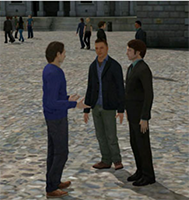
Photo: ©Ennis et al. Seeing is Believing: Body Motion Dominates in Multisensory Conversations. In: ACM Transactions on Graphics, 29(4), pp. 1-9, 2010
Contact:
Dr. Andrea Bönsch
Bachelor Thesis: Integrating Human Users into Crowd Simulations
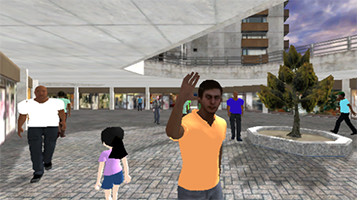 Computer-controlled, embodied, and intelligent virtual agents are increasingly often embedded in various applications to enliven the virtual sceneries. Here, crowd simulations focusing mainly on agent-agent-dynamics and agent-agent-interactions are common. The goal of this bachelor thesis is to implement two existing crowd simulations, while human user(s) have to be actively integrated: the virtual agents of the crowd have to react reasonably to the presence of human users by, e.g., actively avoiding collisions, establishing eye contact during the approaching phases, or deciding depending on the current situation if they cross between several users or walk around them. In addition, human users should be able to manipulate the scene by adding or deleting primitive barriers or flow lines to actively alter the agent flow in the crowd simulation.
Computer-controlled, embodied, and intelligent virtual agents are increasingly often embedded in various applications to enliven the virtual sceneries. Here, crowd simulations focusing mainly on agent-agent-dynamics and agent-agent-interactions are common. The goal of this bachelor thesis is to implement two existing crowd simulations, while human user(s) have to be actively integrated: the virtual agents of the crowd have to react reasonably to the presence of human users by, e.g., actively avoiding collisions, establishing eye contact during the approaching phases, or deciding depending on the current situation if they cross between several users or walk around them. In addition, human users should be able to manipulate the scene by adding or deleting primitive barriers or flow lines to actively alter the agent flow in the crowd simulation.
Photo: ©Kyriakou et al.: Interaction with Virtual Crowds in Immersive and Semi-Immersive Virtual Reality Systems. In: Computer Animation and Virtual Worlds, 28:5, 2017
Contact:
Dr. Andrea Bönsch
Bachelor Thesis: Supporting Scene Exploration in the Realm of Social Virtual Reality
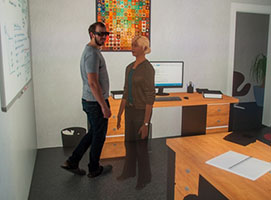 Experiencing a specific virtual world for the very first time requires suitable exploring strategies to quickly visit and remember all locations of interest. One option is to embed a computer-controlled, embodied, intelligent, and conversational virtual agent taking over the role of a virtual guide. The goal of this bachelor thesis to design the behavior such a virtual guide. Thereby, aspects, i.e., maintaining personal space, establishing eye contact, leading versus walking side-by-side, and more have to be adequately considered. In addition, strategies avoiding losing contact with the human user should be integrated.
Experiencing a specific virtual world for the very first time requires suitable exploring strategies to quickly visit and remember all locations of interest. One option is to embed a computer-controlled, embodied, intelligent, and conversational virtual agent taking over the role of a virtual guide. The goal of this bachelor thesis to design the behavior such a virtual guide. Thereby, aspects, i.e., maintaining personal space, establishing eye contact, leading versus walking side-by-side, and more have to be adequately considered. In addition, strategies avoiding losing contact with the human user should be integrated.
Contact:
Dr. Andrea Bönsch
Master Thesis: Efficient Terrain Rendering for Virtual Reality Applications with Level of Detail via Progressive Meshes
Terrain rendering is a major and widely researched field. It has a variety of applications, from software that allows the user to interactively explore a surface, like NASA World Wind or Google Earth, over flight simulators to computer games. It is not surprising that terrain rendering is also interesting for virtual reality applications as virtual reality can also be a tool to support the solution of difficult problems by providing natural ways of interaction. In combination virtual reality and terrain rendering can combine their solution promoting potential.
In this work the terrain representing LOD structure will be a Progressive Mesh (PM) constructed from an unconnected point cloud. A preprocessing step first connects the point cloud so that it forms a triangle mesh which approximates the underlying surface. Then the mesh can be decimated so that the data volume of the PM can be reduced if needed. When the mesh has the desired complexity the actual Progressive Mesh structure is build. Afterwards, real-time rendering just needs to read the PM structure from a file and can perform a selective refinement on it to match the current viewer position and direction.
Contact:
Prof. Dr. Tom Vierjahn
Master Thesis: Voxel-based Transparency: Comparing Rasterization and Volume Ray Casting
This thesis deals with a performance visualization scheme, which represents the load factor of single threads on a high performance computer through colored voxels. The voxels are arranged in a three-dimensional grid so only the shell of the grid is initially visible. The aim of this thesis is to introduce transparent voxels to the visualization in order to let the user look also into the inside of the grid and thereby display more information at once.
First, an intuitive user interface for assigning transparencies to each voxel is presented. For the actual rendering of transparent voxels, two different approaches are then examined: rasterization and volume ray casting. Efficient implementations of both transparency rendering techniques are realized by exploiting the special structure of the voxel grid. The resulting algorithms are able to render even very large grids of transparent voxels in real-time. A more detailed comparison of both approaches eventually points out the better suited of the two methods and shows to what extent the transparency rendering enhances the performance visualization.
Contact:
Prof. Dr. Tom Vierjahn
Bachelor Thesis: Designing and Implementing Data Structures and Graphical Tools for Data Flow Networks Controlling Virtual Environments
In this bachelor thesis a software tool for editing graphs is designed and implemented. There exist some interactive tools but this new tool is specifically aimed at creating, editing and working with graphs representing data flow networks like they appear in virtual environments. This thesis compares existing tools and documents the implementation process of VistaViz (the application). In the current stage of development, VistaViz is able to create new graphs, load existing ones and make them editable interactively.
Contact:
Prof. Dr. Tom Vierjahn
Master Thesis: Raycasting of Hybrid Scenes for Interactive Virtual Environments
Scientific virtual reality applications often make use of both geometry and volume data. For example in medical applications, a three dimensional scan of the patient such as a CT scan results in a volume dataset. Ray casting could make the algorithms needed to handle these hybrid scenes significantly simpler than the more traditional rasterizing algorithms. It is a very flexible and powerful way of generating images of virtual environments. Also there are many effects that can be easily realized using ray-based algorithms such as shadows and ambient occlusion.
This thesis describes a ray casting renderer that was implemented in order to measure how well a ray casting based renderer performs and if it is feasible to use it to visualize interactive virtual environments. Having a performance baseline for an implementation of a modern ray caster has multiple advantages. The renderer itself could be used to measure how different techniques could improve the performance of the ray casting. Also with such a renderer it is possible to test hardware. This helps to estimate how much the available hardware would have to improve in order to make ray casting a sensible choice for rendering virtual environments.
Contact:
Prof. Dr. Tom Vierjahn
Master Thesis: CPU Ray-Tracing in ViSTA
Scientific data visualization is an inherent tool in modern science. Virtual reality (VR) is one of the areas where data visualization constitutes an indispensable part. Current advances in VR as well as the growing ubiquitousness of the VR tools bring the necessity to visualize large data volumes in real time to the forefront. However, it also presents new challenges to the visualization software used in high performance computer clusters.
CPU-based real-time rendering algorithms can be used in such visualization tasks. However, they only recently started to achieve real-time performance, mostly due to the progress in hardware development. Currently ray tracing is one of the most promising algorithms for CPU-based real-time rendering. This work aims at studying the possibility to use CPU-based ray tracing in VR scenarios. In particular, we consider the CPU-based rendering algorithm implemented in the Intel OSPRay framework. For VR tasks, the ViSTA Virtual Reality Toolkit, developed at the Virtual Reality and Immersive Visualization Group at RWTH Aachen University is used.
Contact:
Prof. Dr. Tom Vierjahn
Master Thesis: Streaming Interactive 3D-Applications to Web Environments
This thesis develops a framework for streaming interactive 3D-applications to web environments. The framework uses a classical client-server architecture where the client is implemented as a web application. The framework aims at providing a flexible and scalable solution for streaming an application inside a local network as well as remotely over the internet. It supports streaming to multiple clients simultaneously and provides solutions for handling the input of multiple users as well as streaming at multiple resolutions. Its main focus lies on reducing the latency perceived by the user. The thesis evaluates the image-based compression standards JPEG and ETC as well as the video-based compression standards H.264 and H.265 for use in the framework. The communication between the client and the server was implemented using standardized web technologies such as WebSockets and WebRTC. The framework was integrated into a real-world application and was able to stream it locally and remotely achieving satisfying latencies.
Contact:
Prof. Dr. Tom Vierjahn
Master Thesis: Benchmarking interactive Rendering Frameworks for virtual Environments
In recent years virtual reality applications that utilize head mounted displays have become more popular due to the release of head mounted displays such as the Oculus Rift and the HTC Vive. Applications that utilize head mounted displays, however, require very fast rendering algorithms. Traditionally, the most common way to achieve real time rendering is triangle rasterization; another approach is ray tracing.
In order to provide insight into the performance behavior of rasterization and raytracing, in this Master thesis a toolkit for benchmarking the performance of different rendering frameworks under different conditions was implemented. It was used to benchmark the performance of CPU-ray-tracing-based, GPU-ray-tracing-based and rasterization-based rendering in order to identify the influence of different factors on the rendering time for different rendering schemes.
Contact:
Prof. Dr. Tom Vierjahn
Master Thesis: Generating co-verbal Gestures for a Virtual Human using Recurrent Neural Networks [in progress]
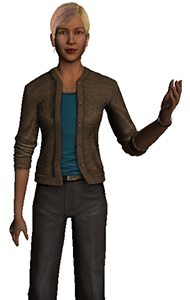 Virtual Humans can be embedded into virtual environments to guide the user through scenes and teach or point out interesting areas. Thereby their behavior has a large influence on the authenticity of the virtual environment and the immersion of a user. One important aspect to this behavior is their movement during speech: co-verbal gestures. The goal of this thesis is to design, develop and test a system to generate authentic co-verbal gestures using RNNs, e.g., Long-Short-Term-Memory (LSTM) networks. Training data for these networks will be provided. The system should become part of an already existing larger software suite to embed believable Virtual Humans into our framework.
(Photo: ©USC Institute for Creative Technologies)
Virtual Humans can be embedded into virtual environments to guide the user through scenes and teach or point out interesting areas. Thereby their behavior has a large influence on the authenticity of the virtual environment and the immersion of a user. One important aspect to this behavior is their movement during speech: co-verbal gestures. The goal of this thesis is to design, develop and test a system to generate authentic co-verbal gestures using RNNs, e.g., Long-Short-Term-Memory (LSTM) networks. Training data for these networks will be provided. The system should become part of an already existing larger software suite to embed believable Virtual Humans into our framework.
(Photo: ©USC Institute for Creative Technologies)
Contact:
Jonathan Ehret, M.Sc.
Master Thesis: Extraction and Interactive Rendering of Dissipation Element Geometry – A ParaView Plugin
After approximate Dissipation Elements (DE) were introduced by Vierjahn et al., the goal of this work is to make their results available for users in the field of fluid mechanics in form of a ParaView plugin, a standard software in this field. It allows to convert DE trajectories into the approximated, tube- like, form and render it via ray tracing and classic OpenGL rendering.
The results are suggesting it is ready to be tested by engineers working with ParaView, as interactive frame rates and fast loading times are achieved. By using approximated DEs instead of DE trajectories, significant amounts of data storage can be saved.
Contact:
Prof. Dr. Tom Vierjahn
Bachelor Thesis: Comparison and Evaluation of two Frameworks for in situ Visualization
On the road to exa-scale computing, the widening gap between I/O-capabilities and compute power of today’s compute clusters encourages the use of in situ methods. This thesis evaluates two frameworks designed to simplify in situ coupling, namely SENSEI and Conduit, and compares them in terms of runtime overhead, memory footprint, and implementation complexity. The frameworks were used to implement in situ pipelines between a proxy simulation and an analysis based on the OSPRay ray tracing framework. The frameworks facilitate a low-complexity integration of in situ analysis methods, providing considerable speedups with an acceptable memory footprint. The use of general-purpose in situ coupling frameworks allows for an easy integration of simulations with analysis methods, providing the advantages of in situ methods with little effort.
Contact:
Prof. Dr. Tom Vierjahn
Master Thesis: An Intelligent Recommendation System for an Efficient and Effective Control of Virtual Agents in a Wizard-of-Oz paradigm.
In this work, techniques were studied to control virtual agents embedded as interaction
partners in immersive, virtual environments. He implemented a graphical user interface (GUI) for
a Wizard-of-Oz paradigm, allowing to select and control individual virtual agents manually. The key
component of the GUI is an intelligent recommendation system predicting which virtual agents are
very likely to be the next interaction partners based on the user’s actions in order to allow an
efficient and effective control.
Published as poster at VRST 2017.
Contact:
Dr. Andrea Bönsch
Master Thesis: Automatic Virtual Tour Generation for Immersive Virtual Environments based on Viewpoint Quality
The exploration of a virtual environment is often the first and one of the most important actions a user performs when experiencing it for the first time, as knowledge of the scene and a cognitive map of the environment are prerequisites for many other tasks. However, as the user does not know the environment, their exploration path is likely to be flawed, taking longer than necessary, missing important parts of the scene and visiting other parts multiple times by accident.
This can be remedied by virtual tours that provide an efficient path through the environment that visits all important places. However, for most virtual environments, manually created virtual tours are not available. Furthermore, most scenes are not provided with the information of where the most important locations are, such that automatic generation of good virtual tours is challenging. However, the informativeness of a position in a virtual environment can be computed automatically using viewpoint quality estimation techniques. In addition to providing interesting places as waypoints, this concept also allows the evaluation of the quality of the tour between waypoints.
Therefore, in this thesis, an automatic method to compute efficient and informative virtual tours through a virtual scenery is designed and developed, based on an evolutionary approach that aims at maximizing the quality of the viewpoints encountered during the tour.
Contact:
Dr. Sebastian Freitag
Master Thesis: Fluid Sketching - 3D Sketching Based on Fluid Flow in Immersive Virtual Environments
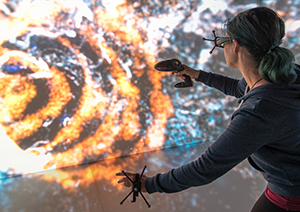 In general, fluid artwork can be seen as photographing smoke, ink injection into water, or marbling. Based on this idea, Fluid Sketching which is a novel medium for creating 3D fluid artwork in immersive virtual environments is studied in this thesis. The application allows artists to draw 3D fluid like sketches and manipulate them by using 6DOF input devices. Users are able to use different sets of brush strokes which vary in color, density, size, initial speed and viscosity of the fluid. Because of fluids' nature, the diffusion of the drawn fluid sketch is animated, and artists have control over altering the fluid properties and stopping the diffusion process whenever they think that they have an appealing view. Furthermore, they can shape the drawn sketch by directly interacting with it, using a hand or by blowing into the fluid. Hand interaction is realized via a hand tracker and the blowing metaphor is obtained by using a microphone. The implementation is mostly done on the GPU, where a particle system and billboards are used for animation and rendering. Curl-noise, which is a procedural method for animating fluid flow, has been used for the particle animation. This gives the artist a higher degree of animator control with low memory usage compared to computational fluid dynamics (CFD) based approaches which are commonly used for simulating fluid flow. Due to its low computational cost, it furthermore allows rendering larger particle populations with a given computational budget. Curl-noise method generates plausible fluid advection fields by evaluating the curl of 3D Simplex noise. Particle-particle and particle-user interaction are realized by using an underlying low-resolution grid which keeps averaged velocities of the particles in the individual cells.
In general, fluid artwork can be seen as photographing smoke, ink injection into water, or marbling. Based on this idea, Fluid Sketching which is a novel medium for creating 3D fluid artwork in immersive virtual environments is studied in this thesis. The application allows artists to draw 3D fluid like sketches and manipulate them by using 6DOF input devices. Users are able to use different sets of brush strokes which vary in color, density, size, initial speed and viscosity of the fluid. Because of fluids' nature, the diffusion of the drawn fluid sketch is animated, and artists have control over altering the fluid properties and stopping the diffusion process whenever they think that they have an appealing view. Furthermore, they can shape the drawn sketch by directly interacting with it, using a hand or by blowing into the fluid. Hand interaction is realized via a hand tracker and the blowing metaphor is obtained by using a microphone. The implementation is mostly done on the GPU, where a particle system and billboards are used for animation and rendering. Curl-noise, which is a procedural method for animating fluid flow, has been used for the particle animation. This gives the artist a higher degree of animator control with low memory usage compared to computational fluid dynamics (CFD) based approaches which are commonly used for simulating fluid flow. Due to its low computational cost, it furthermore allows rendering larger particle populations with a given computational budget. Curl-noise method generates plausible fluid advection fields by evaluating the curl of 3D Simplex noise. Particle-particle and particle-user interaction are realized by using an underlying low-resolution grid which keeps averaged velocities of the particles in the individual cells.
Published at IEEE Virtual Reality 2018 as conference paper.
Contact:
Dipl.-Medieninform. Sascha Gebhardt
Bachelor Thesis: Conformal Mapping of the Cortical Surface
The cerebral cortex holds most of the cerebrum’s functional processing ability. To visualize functional areas on the cortical surface, the cortical surface is usually mapped to a representation which makes the convoluted areas of the brain visible. This work focuses on mapping the surface into the 2D domain. For this purpose, two parameterization algorithms have been implemented: Linear Angle Based Parameterization (Zayer et al., 2007) and Least Squares Conformal Maps (Lévy et al., 2002). The results of the two algorithms are then compared to the iterative flattening approach by Fischl et al. regarding computational time and introduced distortions.
Contact:
Dr. Claudia Hänel

